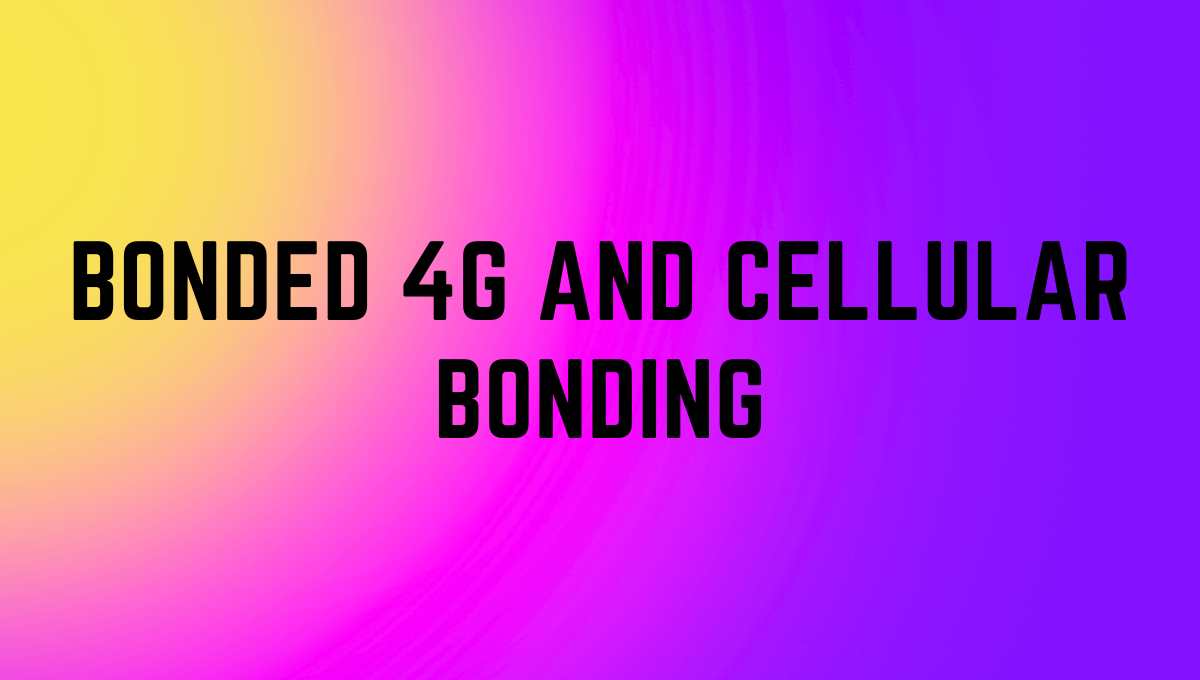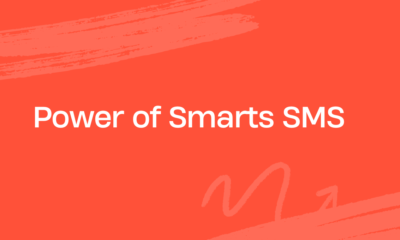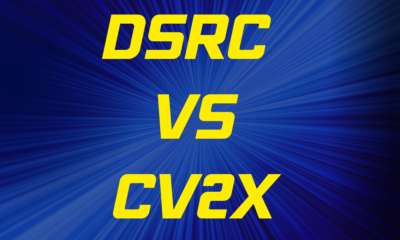Tech
Revolutionizing Connectivity: Bonded 4G and Cellular Bonding
Are you tired of dealing with slow internet connections and frustrating dropped calls? Well, get ready to say goodbye to those connectivity woes! In today’s fast-paced world, staying connected is crucial, whether it’s for work or leisure. That’s why we’re here to introduce you to the groundbreaking technology that is revolutionizing connectivity: bonded 4G and cellular bonding. Say hello to lightning-fast speeds, uninterrupted video streaming, and crystal-clear voice calls – all thanks to this game-changing innovation. Get ready to bid farewell to lagging downloads and endless buffering as we delve into the exciting world of bonded 4G and cellular bonding – a game-changer you won’t want to miss!
Published
2 years agoon
By
Adva
Introduction: The Convergence of Technologies
The demand for fast, reliable data transmission is ever-increasing in today’s interconnected world. Technologies like Bonded 4G, Cellular Bonding, and IP Video Transmission are at the forefront of meeting this demand. They offer robust, flexible solutions for various applications, from mobile broadcasting to emergency response systems. This article aims to delve deep into these technologies, exploring their functionalities, advantages, and best practices for achieving optimal performance.
The convergence of these technologies is not just a trend but a necessity. As the world becomes more reliant on digital communication, traditional data, and video transmission methods are becoming obsolete. Bonded 4G, Cellular Bonding, and IP Video Transmission represent the next step in the evolution of digital communication, offering more reliable and efficient methods for transmitting data and video over the Internet.
Understanding Bonded 4G
What is Bonded 4G?
Bonded 4G is a technology that combines multiple 4G LTE connections to create a single, more robust data pipeline. This is particularly beneficial in areas with poor connectivity, where a single 4G connection may need to provide more bandwidth or reliability. By combining multiple connections, Bonded 4G ensures a more stable and faster data transmission, making it ideal for applications like mobile broadcasting and emergency response systems.
Bonded 4G has previously been demonstrated, but its applications are continually evolving. Bonded 4G is quickly becoming the go-to solution for overcoming the limitations of individual 4G connections; whether streaming high-definition video or transmitting large data files, Bonded 4G provides a dependable and efficient solution.
Advantages of Bonded 4G
The key benefit of adopting Bonded 4G is that it may give a consistent, high-speed internet connection. Users can attain speeds and dependability that would be difficult or impossible with a single 4G connection by aggregating numerous 4G connections. This is especially advantageous for applications requiring high data throughput, such as video streaming or massive file transfers.
Another significant benefit of Bonded 4G is its versatility. It can be used in a variety of settings, from mobile news vans covering live events to remote work setups where reliable Internet is a must. The technology is also scalable, allowing for the addition of more 4G connections to meet increasing data demands.
Cellular Bonding: The Backbone of Mobile Connectivity
What is Cellular Bonding?
Cellular Bonding is similar to Bonded 4G, combining multiple cellular network connections to create a single, more reliable, and faster internet connection. This technology is often used in mobile broadcasting, live event streaming, and emergency response systems. It provides a way to ensure that data transmission remains stable, even in environments where individual cellular connections may be unreliable.
Cellular bonding is not just a backup option for poor connectivity; it’s a proactive solution for ensuring reliable data transmission. By using multiple cellular connections, Cellular Bonding can dynamically distribute data packets, providing that each connection is used to its fullest potential. This results in faster, more reliable data transmission, making it ideal for critical applications like live broadcasting or emergency response.
Components Involved in Cellular Bonding
Cellular bonding involves several key components, including modems, routers, and bonding algorithms. These components manage multiple cellular connections, distribute data packets efficiently, and ensure a stable and fast internet connection. The technology relies heavily on the bonding algorithm, which determines how to distribute the data packets across the available cellular connections.
The choice of components can significantly impact the performance of a Cellular Bonding setup. High-quality modems and routers are essential for ensuring that the multiple cellular connections are managed effectively. Similarly, the bonding algorithm must be sophisticated enough to adapt to changing network conditions, ensuring data transmission remains stable even when individual connections fluctuate.

IP Video Transmission: Revolutionizing Media Broadcasting
What is IP Video Transmission?
IP Video Transmission refers to sending video data over an Internet Protocol (IP) network. This technology has revolutionized the broadcasting industry, allowing for more flexible and cost-effective solutions than traditional broadcasting methods. IP video transmission is commonly used in live streaming, video conferencing, and surveillance systems, offering a more scalable and flexible solution for transmitting video data.
The rise of IP Video Transmission can be attributed to several factors, including advances in compression algorithms and the widespread availability of high-speed Internet. These factors have made transmitting high-quality video over IP networks more accessible and cost-effective. Whether a live broadcast of a sporting event or a corporate video conference, IP Video Transmission provides a reliable and efficient means of video communication.
Advantages of IP Video Transmission
The primary advantage of IP Video Transmission is its flexibility and scalability. Unlike traditional broadcasting methods, which often require dedicated hardware and infrastructure, IP video transmission allows for easy addition or removal of endpoints. This makes it highly adaptable to various needs, from small-scale video conferencing to large-scale live broadcasts.
Another key advantage is the video transmission quality. When compared to older techniques, IP Video Transmission frequently provides higher quality and shorter latency. This is especially critical for real-time video communication applications like healthcare or live broadcasting. The system also supports a variety of video formats and resolutions, giving customers more options.
The Future of Data and Video Transmission
Bonded 4G, Cellular Bonding, and IP Video Transmission are more than just buzzwords; they are technologies shaping the future of data and video transmission. You may dramatically improve the performance and reliability of your data and video transmission systems by knowing the complexities of these technologies and applying best practices. These technologies provide a view into the future of digital communication, distinguished by speed, dependability, and flexibility.
The demand for quick and reliable data transmission will only increase as the world continues to digital. Bonded 4G, Cellular Bonding, and IP Video Transmission are ideally positioned to fulfill this need, with strong, scalable solutions for a variety of applications. Whether you’re a broadcaster, a first responder, or someone who needs reliable Internet, these technologies offer promising avenues for staying connected in our increasingly digital world.
Article FAQs:
- How Does Bonded 4G Differ from Regular 4G?
- Bonded 4G is an enhanced version of regular 4G. While a regular 4G connection relies on a single cellular network for data transmission, Bonded 4G combines multiple 4G connections to create a more robust and reliable data pipeline. This results in faster speeds and greater reliability, especially in areas with spotty network coverage.
- The technology behind Bonded 4G involves specialized software and hardware that can manage multiple 4G connections simultaneously. This allows for dynamic allocation of data packets, ensuring that each connection is used optimally. As a result, Bonded 4G is often the preferred choice for critical applications that require high-speed and reliable internet connectivity.
- Is Cellular Bonding Only Useful for Mobile Applications?
- While Cellular Bonding is often associated with mobile applications like broadcasting and emergency response, it’s not limited to these use cases. Cellular bonding can also be used in fixed locations where traditional broadband connections are unreliable or unavailable. For example, rural areas or temporary event venues can benefit from cellular bonding to achieve stable and high-speed internet connectivity.
- The versatility of cellular bonding makes it a suitable solution for various scenarios. Whether providing internet connectivity for a remote office or ensuring stable data transmission for a live event, cellular bonding offers a reliable and flexible solution that can adapt to different needs and environments.
- Can IP Video Transmission Work Over Any IP Network?
- IP Video Transmission is designed to work over Internet Protocol (IP) networks, but the quality and reliability can vary depending on the network’s capabilities. Factors such as bandwidth, latency, and packet loss can significantly impact video transmission quality. Therefore, it’s recommended to use a high-speed and reliable network for optimal performance.
- While IP Video Transmission can technically work over any IP network, using a dedicated or high-quality network is often advisable for critical applications. For instance, live broadcasting or telemedicine services would benefit from a network that can guarantee high bandwidth and low latency to ensure smooth and high-quality video transmission.
- Is Specialized Equipment Required for These Technologies?
- Specialized equipment is generally required to implement Bonded 4G, Cellular Bonding, and IP Video Transmission. For Bonded 4G and Cellular Bonding, you’ll need multiple modems and a bonding router to manage these connections. For IP Video Transmission, you may require specialized encoders, decoders, and a robust networking setup.
- The type of equipment needed can vary depending on the specific requirements of your application. For example, mobile broadcasting units may require portable, battery-operated equipment, while a fixed setup like a remote office might use more traditional, plug-in devices. Regardless of the application, choosing high-quality, reliable equipment is crucial to get the most out of these technologies.
As a freelance tech and startup news writer, I'm always looking to stay up-to-date with the latest in the industry. I have a background in web development and marketing, so I'm particularly interested in how new startups are using technology to change the world.

You may like
Business Solutions
Geneo Glam: Skin Firming Treatment for Radiant, Youthful Skin
Geneo Glam is the ultimate skin firming treatment designed to restore elasticity, enhance radiance, and leave you with a glowing, youthful complexion.
Published
12 hours agoon
May 9, 2025By
Marks Strand
The Geneo Glam skin firming treatment is a luxurious, non-invasive facial that revitalizes the skin by improving firmness, elasticity, and hydration. Using advanced OxyPod technology, this treatment delivers a unique combination of exfoliation, oxygenation, and infusion of active ingredients to help the skin look smoother, tighter, and more radiant.
Key Benefits
- Firms and Hydrates
The treatment boosts collagen and elastin production, helping skin feel firmer and more supple. - Improves Elasticity
Increases the skin’s resilience and reduces the appearance of fine lines and wrinkles. - Prevents Collagen Breakdown
Helps preserve the skin’s youthful structure by protecting existing collagen and supporting healthy cell function.
Powerful Natural Ingredients
- 24K Gold Particles
Stimulate collagen production, protect skin fibers, and encourage cell renewal for a firmer, lifted appearance. - Silk Amino Acids
Strengthen the skin barrier, lock in moisture, and support collagen synthesis to reduce visible signs of aging. - Carnosine Peptides
Help protect the skin from sugar-related damage (glycation), delay cellular aging, and extend the life of skin cells. - Copper
An antioxidant and anti-inflammatory that supports collagen development, smooths fine lines, and helps with skin regeneration.
How the Treatment Works
- Exfoliation and Oxygenation
The Geneo Glam OxyPod is activated with a Primer Gel, gently exfoliating the skin and triggering a natural oxygenation process that increases blood flow and enhances skin vitality. - Infusion of Actives
Active ingredients such as gold particles, peptides, and amino acids are infused deep into the skin to firm and rejuvenate. - Hydration and Nourishment
A final serum containing hyaluronic acid, rosehip oil, and marula oil hydrates and soothes the skin, leaving it soft and glowing.
Who Should Try Geneo Glam?
This treatment is ideal for people who want to:
- Reduce fine lines and early signs of aging
- Firm and tighten sagging skin
- Restore hydration and improve skin tone
Geneo Glam offers a refreshing way to firm, lift, and hydrate your skin—leaving you with a youthful glow and smooth, resilient skin. It’s a perfect solution for anyone seeking visible results without invasive procedures or downtime.
Business Solutions
H.265 miniature UAV encoders: A comprehensive Overview
H.265 miniature UAV encoders revolutionize aerial technology with advanced video compression, ensuring high efficiency and superior performance for modern UAV systems.
Published
2 days agoon
May 8, 2025By
Adva
As the demand for high-quality, real-time video transmission from unmanned aerial vehicles (UAVs) continues to rise in both military and commercial applications, the need for efficient, compact video encoding solutions has become paramount. H.265 miniature UAV encoders represent a significant advancement in this space, providing robust video compression in a small, lightweight package ideal for drones with stringent size, weight, and power (SWaP) constraints. Leveraging the power of High Efficiency Video Coding (HEVC), also known as H.265, these encoders allow UAVs to deliver high-resolution video over constrained data links, enhancing situational awareness and operational effectiveness without overwhelming available bandwidth.
H.265 is a video compression standard that succeeds H.264/AVC and offers approximately double the data compression ratio at the same video quality level. This efficiency is particularly beneficial for UAV applications, where bandwidth and power availability are limited, especially during beyond-line-of-sight (BLOS) missions or in contested environments. With H.265 encoders, UAVs can stream 1080p or even 4K encoder video in real time while consuming significantly less data than older standards. This is critical for operations such as intelligence, surveillance, and reconnaissance (ISR), where maintaining video clarity over long distances or through relay networks is essential for accurate decision-making.
Miniature H.265 UAV encoders are engineered to operate under harsh environmental conditions while maintaining optimal performance. These devices are typically ruggedized, featuring extended temperature ranges, shock resistance, and electromagnetic shielding to ensure reliable operation in military or field environments. Despite their small size—often no larger than a deck of cards—they include advanced features such as low-latency encoding, dynamic bitrate control, encryption, and support for multiple streaming protocols including RTSP, RTP, and MPEG-TS. This allows them to integrate seamlessly into existing command-and-control infrastructure and support a variety of end-user applications, from real-time ground monitoring to autonomous navigation and object tracking.

The integration of H.265 encoders into small UAVs has significantly expanded the capability of tactical drone systems. For example, military units can deploy hand-launched drones equipped with these encoders to provide persistent ISR coverage over a battlefield, transmitting clear, actionable video intelligence back to command centers in near real time. Law enforcement agencies and border security forces also benefit from these technologies, using UAVs to monitor large or remote areas with minimal personnel. In disaster response scenarios, such encoders enable drones to deliver live aerial assessments of affected regions, helping responders prioritize actions and coordinate relief efforts efficiently.
Beyond video transmission, modern H.265 UAV encoders are increasingly integrated with onboard artificial intelligence modules that enable edge processing. This allows UAVs to perform real-time object recognition, motion detection, and scene analysis directly within the encoder, reducing the need to send raw data to centralized systems for processing. Such capabilities are crucial in time-sensitive missions where latency can affect outcomes, such as tracking moving targets or identifying threats in complex terrain.
Despite their many advantages, the deployment of H.265 miniature encoders does come with some technical considerations. The encoding process, while more efficient than previous standards, requires higher computational resources. Manufacturers must therefore strike a careful balance between processing power, thermal management, and energy consumption. Additionally, the compatibility of H.265 streams with legacy systems remains a factor, as not all ground stations or video players natively support HEVC decoding without updates or specialized software.
Manufacturers of H.265 miniature UAV encoders include companies such as IMT Vislink, Soliton Systems, Haivision, and VITEC, all of which provide solutions tailored to UAV and robotics applications. These encoders are often modular, allowing integrators to select configurations based on mission requirements, payload limitations, and transmission needs. As the ecosystem of compact, high-efficiency video systems grows, continued innovation in low-power silicon and AI integration is expected to drive the next wave of capability enhancements in this field.
In the evolving landscape of drone technology, H.265 miniature UAV encoders stand out as a critical enabler of high-performance video transmission. By combining advanced compression with minimal SWaP impact, these systems provide UAV operators with the tools to observe, analyze, and act with unprecedented precision and clarity—no matter how small the platform or how demanding the environment.
Business Solutions
IEEE 802.11p and V2X Communication: Enabling Smarter, Safer Roads
IEEE 802.11p revolutionizes V2X communication, driving smarter, safer roads through advanced vehicle connectivity. This cutting-edge technology enhances transportation systems, enabling intelligent and secure interactions for a safer future.
Published
2 days agoon
May 7, 2025By
Adva
Modern vehicles are no longer isolated machines; they are becoming intelligent, connected nodes within a larger transportation ecosystem. At the heart of this transformation is Vehicle-to-Everything (V2X) communication, which enables cars to talk to each other and to the infrastructure around them. One of the first and most influential technologies developed to support V2X is the IEEE 802.11p standard—a wireless standard specifically tailored for vehicular environments.
What is IEEE 802.11p?
IEEE 802.11p is an amendment to the IEEE 802.11 standard (commonly known as Wi-Fi), designed to enable wireless access in vehicular environments. It was approved in 2010 and forms the basis for Dedicated Short-Range Communications (DSRC).
Key Characteristics of 802.11p:
- Frequency Band: Operates in the 5.9 GHz band reserved for Intelligent Transportation Systems (ITS).
- Low Latency: Optimized for fast, real-time communication necessary for safety-critical applications.
- Range: Effective communication range of up to 1 kilometer, suitable for high-speed vehicle interaction.
- Decentralized Architecture: Enables direct communication (V2V and V2I) without the need for cellular or network infrastructure.
- Robustness: Handles high-speed mobility and rapidly changing topologies typical of vehicular environments.

Role of 802.11p in V2X Communication
V2X (Vehicle-to-Everything) is a broader term encompassing various communication paradigms, including:
- V2V (Vehicle-to-Vehicle)
- V2I (Vehicle-to-Infrastructure)
- V2P (Vehicle-to-Pedestrian)
- V2N (Vehicle-to-Network)
- V2C (Vehicle-to-Cloud)
802.11p primarily supports V2V and V2I communications, forming the backbone of DSRC-based V2X implementations. Its low latency and direct communication capabilities make it ideal for applications such as:
- Forward collision warnings
- Intersection movement assist
- Emergency electronic brake lights
- Lane change warnings
Comparison with Cellular V2X (C-V2X)
As V2X technology has evolved, C-V2X (based on LTE and 5G standards) has emerged as a strong alternative to 802.11p. Here’s how they compare:
| Feature | IEEE 802.11p (DSRC) | C-V2X (LTE/5G) |
| Latency | ~10 ms | ~5–10 ms (LTE), <5 ms (5G) |
| Coverage | Short-range, direct | Short + long-range via network |
| Deployment | Mature, field-tested | Growing, especially with 5G |
| Infrastructure | Minimal (no cellular needed) | Requires cellular networks (for V2N/V2C) |
| Interoperability | Limited with C-V2X | Newer versions support dual-mode |
Adoption and Use Cases
Global Deployment:
- United States: Initially favored DSRC based on 802.11p, though recent FCC rulings have shifted focus toward C-V2X.
- Europe: ETSI has defined ITS-G5, a protocol stack based on 802.11p.
- Japan and South Korea: Active use of DSRC for tolling and traffic safety.
Real-World Applications:
- Collision avoidance systems
- Smart intersections
- Road hazard notifications
- Platooning for commercial vehicles
- Public transport priority systems
Advantages of 802.11p
- Mature and Proven: Used in numerous pilot programs and early deployments.
- Fast Time to Communication: No need for handshake protocols; devices can communicate almost instantly.
- No Subscription Costs: Operates independently of cellular networks.
Limitations and Challenges
- Scalability: In high-density traffic, packet collisions may reduce reliability.
- Spectrum Allocation: Regulatory changes in some countries have limited the bandwidth available to DSRC.
- Limited Ecosystem Growth: Many automakers and countries are shifting investment to C-V2X and 5G-based platforms.
Future Outlook
While 802.11p has laid the foundation for V2X communication, the industry is gradually pivoting toward more advanced and scalable technologies such as 5G NR-V2X. However, 802.11p remains relevant in regions where DSRC infrastructure is already deployed and continues to serve as a dependable option for immediate, low-latency vehicular communication.
Hybrid Solutions:
Some industry players are exploring dual-mode V2X devices that support both 802.11p and C-V2X, ensuring backward compatibility and smoother transitions.
IEEE 802.11p has played a pivotal role in launching the era of connected vehicles, offering reliable, low-latency communication tailored for high-speed mobility. While newer technologies like C-V2X and 5G are beginning to dominate the roadmap, 802.11p’s contributions remain foundational in the evolution of V2X systems. As the automotive industry moves forward, a mix of technologies, including legacy support for 802.11p, will ensure that safety, efficiency, and connectivity continue to advance on roads around the world.

Geneo Glam: Skin Firming Treatment for Radiant, Youthful Skin

H.265 miniature UAV encoders: A comprehensive Overview

IEEE 802.11p and V2X Communication: Enabling Smarter, Safer Roads
Trending
-
Marketing & Analytics2 years ago
A Complete Guide To HubSpot’s New B2B Marketing, Sales Hub, and Prospecting Tool
-
3D Technology2 years ago
3D Scanner Technology for Android Phones: Unleashing New Possibilities
-
Marketing & Analytics2 years ago
How SMS Services And Software For Bulk SMS Sending Can Help Your Business Grow
-
3D Technology2 years ago
Mobile 3D Scanners: Revolutionizing 3D Scanning Technology
-
3D Technology2 years ago
3D scanning technologies and scanning process
-
Business Solutions1 year ago
Understanding A2P Messaging and the Bulk SMS Business Landscape
-

 Business Solutions1 year ago
Business Solutions1 year agoThe Power of Smarts SMS and Single Platform Chat Messaging
-

 Automotive2 years ago
Automotive2 years agoDSRC vs. CV2X: A Comprehensive Comparison of V2X Communication Technologies



